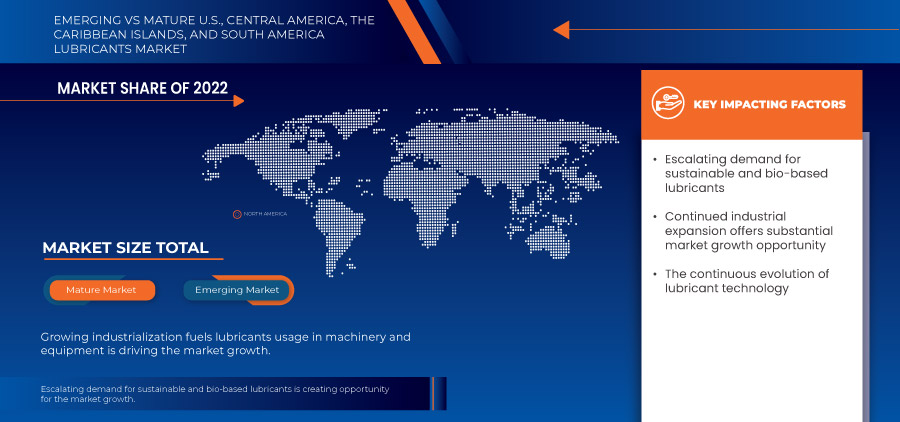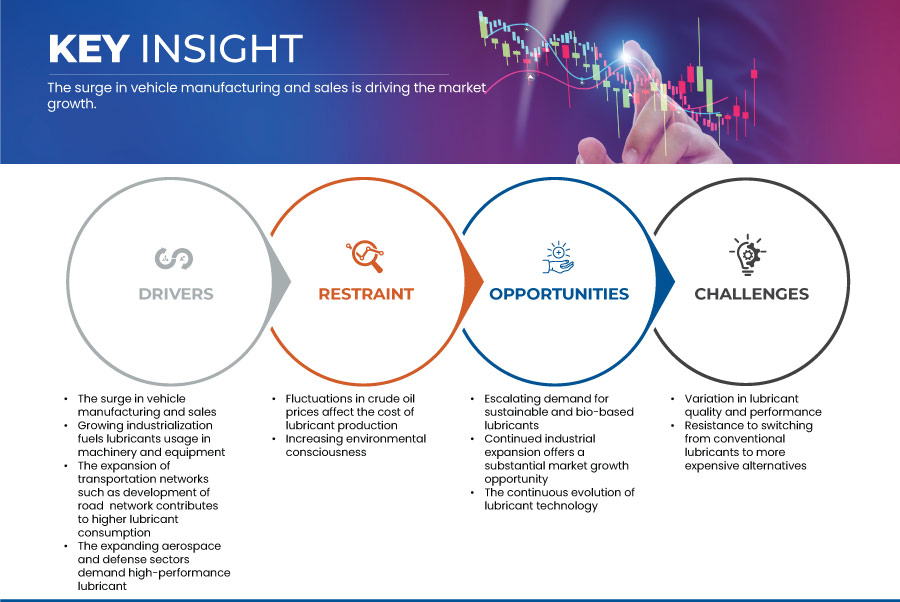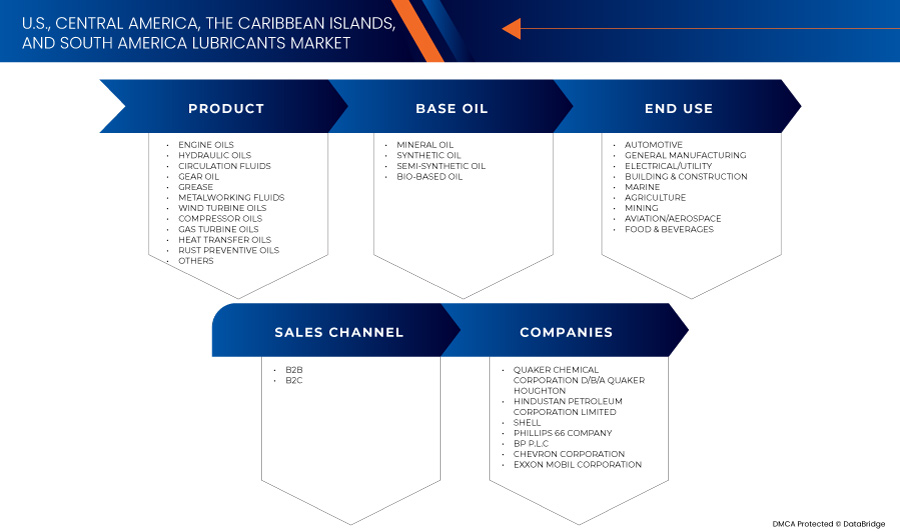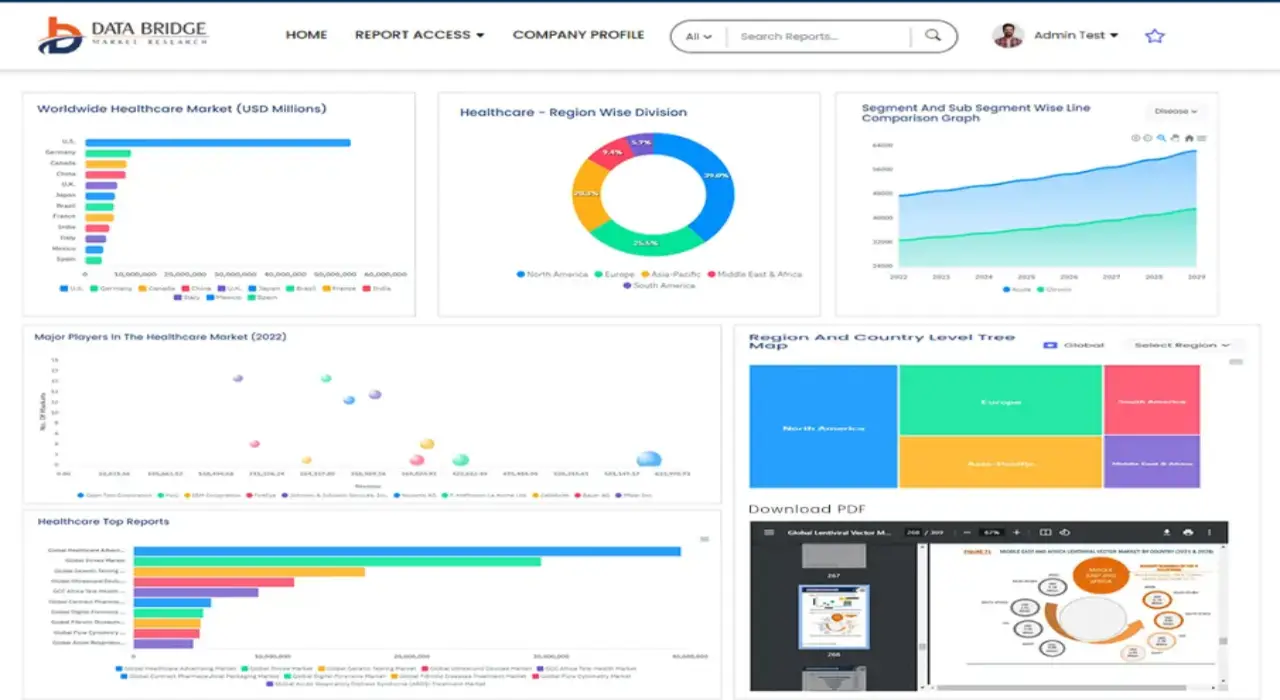U S Central America The Caribbean Islands And South America Lubricants Market
Tamanho do mercado em biliões de dólares
CAGR :
% 
 USD
32.73 Billion
USD
58.38 Billion
2024
2032
USD
32.73 Billion
USD
58.38 Billion
2024
2032
| 2025 –2032 | |
| USD 32.73 Billion | |
| USD 58.38 Billion | |
|
|
|
U.S., Central America, the Caribbean Islands, and South America Lubricants Market Segmentation, By Product (Engine Oils, Hydraulic Oils, Circulation Fluids, Gear Oil, Grease, Metalworking Fluids, Wind Turbine Oils, Compressor Oils, Gas Turbine Oils, Heat Transfer Oils, Rust Preventive Oils, and Others), Base Oil (Mineral Oil, Synthetic Oil, Semi-Synthetic Oil, and Bio-Based Oil), Sales Channel (B2B and B2C), End-Use (Automotive, General Manufacturing, Electrical/Utility, Building & Construction, Marine, AgricultureMining, Aviation/Aerospace, and Food & Beverages) - Industry Trends and Forecast to 2031
Lubricants Market Analysis
The market is driven by vehicle manufacturing and sales are the key factors fuelling the market expansion. Escalating demand for sustainable and bio-based lubricants opportunities for market growth. However, Fluctuations in crude oil prices affect the cost of lubricant production as a notable restraint affecting the market. Furthermore, the highly competitive lubricant industry manufacturers require constant innovation and differentiation challenge market growth. The continuous evolution of lubricant technology is a rising opportunity that has the potential to lead to market growth. Resistance to switching from conventional lubricants to more expensive alternatives have emerged as significant challenges impacting the growth trajectory of the market.
Lubricants Market Size
Data Bridge Market Research analyses that the U.S., Central America, the Caribbean Islands, and South America lubricants market is expected to reach a value of USD 53.79 billion by 2031 from 30.45 billion in 2023, growing at a CAGR of 7.5% during the forecast period 2024 to 2031. In addition to the market insights such as market value, growth rate, market segments, geographical coverage, market players, and market scenario, the market report curated by the Data Bridge Market Research team includes in-depth expert analysis, import/export analysis, pricing analysis, production consumption analysis, and PESTLE analysis
Lubricants Market Trends
“Growing Demand in Automotive and Aerospace”
The automotive and aerospace industries are increasingly utilizing adhesive lubricants to enhance performance and durability in critical components, reducing friction and wear. As vehicles and aircraft advance, these lubricants help improve longevity and reliability, especially in high-stress environments. The shift toward electric and hybrid vehicles necessitates specialized solutions that withstand extreme conditions. Additionally, stricter regulatory standards drive demand for high-performance lubricants that ensure compliance. This combination of factors solidifies the role of adhesive lubricants in future engineering innovations.
Report Scope and Lubricants Market segmentation
|
Report Metric |
Lubricants Market Insights |
|
Segments Covered |
|
|
Countries Covered |
Jamaica, Cuba, Dominican Republic, Haiti, Trinidad & Tobago, Rest of The Caribbean Islands, Guatemala, Costa Rica, Panama, El Salvador, rest of Central America, U.S., Brazil, Argentina, Venezuela, Peru, Chile, and Rest of South America |
|
Key Market Players |
Quaker Chemical Corporation d/b/a Quaker Houghton (U.S.), Hindustan Petroleum Corporation Limited (India), Shell (U.K.), Chevron Corporation (U.S.), Exxon Mobil Corporation (U.S.), BP p.l.c. (U.K.), CARL BECHEN GMBH (Germany), Motul (France), Phillips 66 Company (U.S.), TotalEnergies (France), and Valvoline (U.S.) among others |
|
Market Opportunities |
|
|
Value Added Data |
In addition to the market insights such as market value, growth rate, market segments, geographical coverage, market players, and market scenario, the market report curated by the Data Bridge Market Research team includes in-depth expert analysis, import/export analysis, pricing analysis, production consumption analysis, and PESTLE analysis. |
Lubricants Market Definition
Lubricants are organic compounds employed to minimize friction and heat generation between interacting surfaces. They may also possess properties for conveying forces, particles, or regulating temperature, with the expectation of maintaining their effectiveness at elevated temperatures.
Lubricants Market Dynamics
This section deals with understanding the market drivers, advantages, opportunities, restraints, and challenges. All of this is discussed in detail below:
Drivers
- The Surge in Vehicle Manufacturing and Sales
The market is driven by a variety of factors, including the spike in vehicle production and sales around the world. This growing trend is supported by rising vehicle ownership, technical development, rising maintenance costs, increased global trade, and its knock-on impacts on economic expansion. The lubricants market will be essential in guaranteeing the best performance and sustainability of cars around the world as the automotive industry develops further. Thus, a worldwide surge in vehicle manufacturing and sales is expected to drive market growth.
For instance,
According to GoodCarBadCar, SUV market share in South America saw significant growth, rising from 35% in 2019 to 45% in 2022. This trend indicated positive momentum in the passenger car market, with expectations of continued growth in the coming years. This increase in sales of SUVs influence the demand of lubricants in the region.
- Growing Industrialization Fuels Lubricant Usage in Machinery and Equipment
Growing industrialization is a dynamic and multifaceted driver for the market. It encompasses various industries, sectors, and applications, all of which rely on lubricants for smooth, efficient, and environmentally responsible operations. The lubricants market will remain an essential component of industrial growth and sustainability, ensuring the seamless operation of machinery and equipment across diverse sectors, as industrialization continues to advance. Thus, growing industrialization fuels lubricant usage in machinery and equipment and is expected to drive market growth.
For instance,
- In April 2024, reported by Forst & Sullivan that in March, Stellantis announced a historic EUR 5.6 billion (USD 6081.60 million) investment in Latin America's automotive industry, focusing on electric and hybrid vehicles. This five-year plan, starting in 2025, aims to launch nearly 40 new models and highlights the region's growth potential, with a projected 4.8% YoY increase in 2024. This automotive industry development increases the consumption of specialised lubricants.
Opportunities
- Escalating Demand for Sustainable and Bio-Based Lubricants
The escalating demand for sustainable and bio-based lubricants presents a significant opportunity for the market. Industries and consumers are actively seeking lubricant solutions that are not only effective but also environmentally friendly, as environmental concerns continue to gain momentum. This shift in demand has opened up several avenues for growth and innovation within the lubricants industry. One of the key opportunities lies in the development and production of bio-based lubricants. These lubricants are derived from renewable resources such as plant oils, animal fats, and even microbial sources. Unlike traditional mineral oil-based lubricants, bio-based lubricants have the advantage of being biodegradable and less harmful to the environment. They also offer improved biodegradability and reduced toxicity, making them a preferred choice in applications where environmental impact is a concern.
For instance,
- In the article by STLE org, Biobased lubricants, such as soy-based hydraulic fluid and vegetable oil-derived additives, show promise in various applications, from elevators to farm equipment. They offer advantages such as biodegradability, lower toxicity, and enhanced lubricity, though challenges such as poor oxidation stability and high pour points persist. Innovations aim to overcome these limitations, making biobased lubricants competitive with synthetic counterparts. Recycling remains a challenge, with mixed opinions on its feasibility.
Continued Industrial Expansion Offers a Substantial Market Growth Opportunity
Continued industrial expansion presents a substantial growth opportunity for the market. As economies evolve and industrialization remains a driving force, the demand for lubricants across various sectors is expected to surge. This opportunity arises from the indispensable role lubricants play in maintaining the efficiency, performance, and longevity of industrial machinery and equipment. The rapid urbanization and infrastructure development witnessed in emerging economies. The need for heavy machinery and equipment increases significantly, as these countries invest in building and upgrading infrastructure, such as roads, bridges, airports, and manufacturing facilities. Lubricants are critical for ensuring the smooth operation of these machines, reducing friction, and preventing wear and tear. Moreover, the expansion of construction and infrastructure projects often requires specialized lubricants designed to withstand extreme conditions, further driving demand.
For instance,
- In June 2024, according to the article published by OILPRICE, the Caribbean has seen a surge in renewable energy investments, including solar, geothermal, and battery storage. Projects aim to reduce fossil fuel dependency, boost energy security, and cut costs. Dominica explores geothermal, while Antigua and Barbuda focuses on hurricane-resistant solar. Major projects are underway, including a 128MW solar and 63.2MWh battery auction in the U.S. Virgin Islands by Accion Group and VIElectron.
Restraints/Challenges
- Increasing Environmental Consciousness
Increasing environmental consciousness presents a significant restraint for the market. Industries and consumers similarly are becoming more conscientious about the environmental impact of their choices, as awareness of environmental issues and sustainability grows worldwide. This shift in mindset has several implications for the lubricants industry. The demand for lubricants that are cleaner and more environmentally friendly is one of the main issues. Traditional lubricants frequently contain additives and chemicals that, when released into the environment, can harm ecosystems, especially those that are based on mineral oil. People are increasingly choosing biodegradable and environmentally friendly lubricants that pose fewer threats to soil, water, and wildlife.
For instance,
- In June 2024, according to National Ocean Service, Oil spills from large ships severely impacted marine life, harming birds, mammals, and fish. The spills compromised the insulation of fur-bearing mammals like sea otters and the water repellency of birds' feathers, leading to hypothermia. Juvenile sea turtles became trapped and confused oil for food, while dolphins and whales faced respiratory issues. Many animals ingested oil while cleaning themselves, causing poisoning. Such negative impact on marine environment create awareness among public regarding use of lubricants.
Variation in Lubricant Quality and Performance
Lubricants play a crucial role in the efficient operation of machinery and engines across various industries. Their primary function is to reduce friction, wear, and heat, ensuring smoother and more reliable performance of mechanical systems. High-quality lubricants not only enhance the lifespan of equipment but also contribute to overall operational efficiency and safety. Therefore, maintaining consistent lubricant quality is essential for preventing breakdowns, optimizing performance, and meeting regulatory standards.
For instance,
- In May 2024, Mansfield Energy Corp. highlighted a significant challenge in the lubricant market. The proliferation of products led to varying quality levels, complicating quick lube shops’ efforts to source consistent, high-quality lubricants. This inconsistency caused engine buildup, reduced efficiency, and costly repairs, ultimately risking customer dissatisfaction and damaging shop reputations.
Este relatório de mercado fornece detalhes de novos desenvolvimentos recentes, regulamentos comerciais, análise de importação e exportação, análise de produção, otimização da cadeia de valor, quota de mercado, impacto dos participantes do mercado doméstico e localizado, analisa as oportunidades em termos de bolsas de receitas emergentes, alterações nas regulamentações do mercado, análise estratégica do crescimento do mercado, tamanho do mercado, crescimento do mercado das categorias, nichos de aplicação e dominância, aprovações de produtos, lançamentos de produtos, expansões geográficas, inovações tecnológicas no mercado. Para mais informações sobre o mercado, contacte a Data Bridge Market Research para obter um briefing de analista.
Âmbito do mercado de lubrificantes
O mercado de lubrificantes dos EUA, América Central, Ilhas das Caraíbas e América do Sul está segmentado em quatro segmentos notáveis com base no produto, óleo base, canal de vendas e utilização final. O crescimento entre estes segmentos irá ajudá-lo a analisar segmentos de baixo crescimento nos setores e fornecerá aos utilizadores uma visão geral e informações valiosas do mercado para os ajudar a tomar decisões estratégicas para identificar as principais aplicações do mercado.
Produto
- Óleos de motor
- Óleos de motor, por óleo base
- Óleo mineral
- Óleo Mineral, Por Tipo
- Óleos Parafínicos
- Óleos Naftênicos
- Óleos Aromáticos
- Óleo Mineral, Por Tipo
- Óleo Sintético
- Óleo Sintético, Por Tipo
- Óleo de mistura sintética
- Óleo Sintético Completo
- Óleo Sintético, Por Tipo
- Óleo Semi-Sintético
- Óleo de base biológica
- Óleo mineral
- Óleos de motor, por óleo base
- Óleos Hidráulicos
- Óleos Hidráulicos, Por Óleo Base
- Óleo mineral
- Óleo Mineral, Por Tipo
- Óleos Parafínicos
- Óleos Naftênicos
- Óleos Aromáticos
- Óleo Mineral, Por Tipo
- Óleo Sintético
- Óleo Sintético, Por Tipo
- Óleo de mistura sintética
- Óleo Sintético Completo
- Óleo Sintético, Por Tipo
- Óleo Semi-Sintético
- Óleo de base biológica
- Óleo mineral
- Óleos Hidráulicos, Por Óleo Base
- Fluidos de Circulação
- Fluidos de Circulação, Por Óleo Base
- Óleo mineral
- Óleo Mineral, Por Tipo
- Óleos Parafínicos
- Óleos Naftênicos
- Óleos Aromáticos
- Óleo Mineral, Por Tipo
- Óleo Sintético
- Óleo Sintético, Por Tipo
- Óleo de mistura sintética
- Óleo Sintético Completo
- Óleo Sintético, Por Tipo
- Óleo Semi-Sintético
- Óleo de base biológica
- Óleo mineral
- Fluidos de Circulação, Por Óleo Base
- Óleo para engrenagens
- Óleo de engrenagem, por óleo base
- Óleo mineral
- Óleo Mineral, Por Tipo
- Óleos Parafínicos
- Óleos Naftênicos
- Óleos Aromáticos
- Óleo Mineral, Por Tipo
- Óleo Sintético
- Óleo Sintético, Por Tipo
- Óleo de mistura sintética
- Óleo Sintético Completo
- Óleo Sintético, Por Tipo
- Óleo Semi-Sintético
- Óleo de base biológica
- Óleo mineral
- Óleo de engrenagem, por óleo base
- Graxa
- Massa lubrificante, por tipo
- Baseado em lítio
- Baseado em cálcio
- Baseado em Bentone
- Complexo de Bário
- Outros
- Massa lubrificante, Por Óleo Base
- Óleo mineral
- Óleo Mineral, Por Tipo
- Óleos Parafínicos
- Óleos Naftênicos
- Óleos Aromáticos
- Óleo Mineral, Por Tipo
- Óleo Sintético
- Óleo Sintético, Por Tipo
- Óleo de mistura sintética
- Óleo Sintético Completo
- Óleo Sintético, Por Tipo
- Óleo Semi-Sintético
- Óleo de base biológica
- Óleo mineral
- Massa lubrificante, por tipo
- Fluidos de maquinação
- Fluidos de maquinação, por óleo base
- Óleo mineral
- Óleo Mineral, Por Tipo
- Óleos Parafínicos
- Óleos Naftênicos
- Óleos Aromáticos
- Óleo Mineral, Por Tipo
- Óleo Sintético
- Óleo Sintético, Por Tipo
- Óleo de mistura sintética
- Óleo Sintético Completo
- Óleo Semi-Sintético
- Óleo de base biológica
- Óleo Sintético, Por Tipo
- Óleo mineral
- Fluidos de maquinação, por óleo base
- Óleos para turbinas eólicas
- Óleos para aerogeradores, por óleo base
- Óleo mineral
- Óleo Mineral, Por Tipo
- Óleos Parafínicos
- Óleos Naftênicos
- Óleos Aromáticos
- Óleo Mineral, Por Tipo
- Óleo Sintético
- Óleo Sintético, Por Tipo
- Óleo de mistura sintética
- Óleo Sintético Completo
- Óleo Semi-Sintético
- Óleo de base biológica
- Óleo Sintético, Por Tipo
- Óleo mineral
- Óleos para aerogeradores, por óleo base
- Óleos para compressores
- Óleos para compressores, por óleo base
- Óleo mineral
- Óleo Mineral, Por Tipo
- Óleos Parafínicos
- Óleos Naftênicos
- Óleos Aromáticos
- Óleo Mineral, Por Tipo
- Óleo Sintético
- Óleo Sintético, Por Tipo
- Óleo de mistura sintética
- Óleo Sintético Completo
- Óleo Sintético, Por Tipo
- Óleo Semi-Sintético
- Óleo de base biológica
- Óleo mineral
- Óleos para compressores, por óleo base
- Óleos para turbinas a gás
- Óleos para turbinas a gás, por óleo base
- Óleo mineral
- Óleo Mineral, Por Tipo
- Óleos Parafínicos
- Óleos Naftênicos
- Óleos Aromáticos
- Óleo Mineral, Por Tipo
- Óleo Sintético
- Óleo Sintético, Por Tipo
- Óleo de mistura sintética
- Óleo Sintético Completo
- Óleo Sintético, Por Tipo
- Óleo Semi-Sintético
- Óleo de base biológica
- Óleo mineral
- Óleos para turbinas a gás, por óleo base
- Óleos de transferência de calor
- Óleos de transferência de calor, por óleo base
- Óleo mineral
- Óleo Mineral, Por Tipo
- Óleos Parafínicos
- Óleos Naftênicos
- Óleos Aromáticos
- Óleo Mineral, Por Tipo
- Óleo Sintético
- Óleo Sintético, Por Tipo
- Óleo de mistura sintética
- Óleo Sintético Completo
- Óleo Sintético, Por Tipo
- Óleo Semi-Sintético
- Óleo de base biológica
- Óleo mineral
- Óleos de transferência de calor, por óleo base
- Óleos antiferrugem
- Óleos anti-ferrugem, por óleo base
- Óleo mineral
- Óleo Mineral, Por Tipo
- Óleos Parafínicos
- Óleos Naftênicos
- Óleos Aromáticos
- Óleo Mineral, Por Tipo
- Óleo Sintético
- Óleo Sintético, Por Tipo
- Óleo de mistura sintética
- Óleo Sintético Completo
- Óleo Sintético, Por Tipo
- Óleo Semi-Sintético
- Óleo de base biológica
- Óleo mineral
- Óleos anti-ferrugem, por óleo base
- Outros
- Outros, por óleo base
- Óleo mineral
- Óleo Mineral, Por Tipo
- Óleos Parafínicos
- Óleos Naftênicos
- Óleos Aromáticos
- Óleo Mineral, Por Tipo
- Óleo Sintético
- Óleo Sintético, Por Tipo
- Óleo de mistura sintética
- Óleo Sintético Completo
- Óleo Sintético, Por Tipo
- Óleo Semi-Sintético
- Óleo de base biológica
- Óleo mineral
- Outros, por óleo base
Óleo base
- Óleo mineral
- Óleo Mineral, Por Tipo
- Óleos Parafínicos
- Óleos Naftênicos
- Óleos Aromáticos
- Óleo Mineral, Por Tipo
- Óleo Sintético
- Óleo Sintético, Por Tipo
- Óleo de mistura sintética
- Óleo Sintético Completo
- Óleo Sintético, Por Tipo
- Óleo Semi-Sintético
- Óleo de base biológica
Canal de vendas
- B2B
- B2B, Por Tipo
- Fabricante original de equipamento original
- Pós-venda
- B2B, Por Tipo
- B2C
- B2C, Por Tipo
- Pós-venda
- Fabricante original de equipamento original
- B2C, Por Tipo
Utilizador final
- Automotivo
- Automóvel, Por Tipo de Veículo
- Veículos Comerciais
- Veículos Comerciais, Por Tipo
- Camiões
- Camiões, por tipo
- Camiões Pesados
- Camiões ligeiros
- Camiões, por tipo
- Ônibus
- Outros
- Camiões
- Veículos Comerciais, Por Tipo
- Veículos de Passageiros
- Veículos de Passageiros, Por Tipo
- Carros
- Motocicletas
- Veículos de três rodas
- Outros
- Veículos de Passageiros, Por Tipo
- Veículos Comerciais
- Automóvel, Por Tipo de Veículo
- Fabricação Geral
- Elétrica/Utilidade Pública
- Construção e Edificação
- Marinho
- Agricultura
- Mineração
- Aviação/Aeroespacial
- Alimentos e Bebidas
Análise regional do mercado de lubrificantes
O mercado de lubrificantes dos EUA, América Central, Ilhas das Caraíbas e América do Sul está segmentado em quatro segmentos notáveis com base no produto, óleo base, canal de vendas e utilização final.
The countries covered in the market report as Jamaica, Cuba, Dominican Republic, Haiti, Trinidad & Tobago, Rest of The Caribbean Islands, Guatemala, Costa Rica, Panama, El Salvador, rest of Central America, U.S., Brazil, Argentina, Venezuela, Peru, Chile, and Rest of South America.
U.S. region is expected to dominate the market due to its robust industrial base, stringent quality standards, and strong presence in various sectors.
The country section of the report also provides individual market impacting factors and changes in market regulation that impact the current and future trends of the market. Data points like down-stream and upstream value chain analysis, technical trends and porter's five forces analysis, case studies are some of the pointers used to forecast the market scenario for individual countries. Also, the presence and availability of U.S., South America, Central America and Caribbean Island brands and their challenges faced due to large or scarce competition from local and domestic brands, impact of domestic tariffs and trade routes are considered while providing forecast analysis of the country data.
Lubricants Market Share
The market competitive landscape provides details by competitor. Details included are company overview, company financials, revenue generated, market potential, investment in research and development, new market initiatives, global presence, production sites and facilities, production capacities, company strengths and weaknesses, product launch, product width and breadth, application dominance. The above data points provided are only related to the companies' focus related to market.
Lubricants Market Leaders Operating in the Market are
- Quaker Chemical Corporation d/b/a Quaker Houghton (U.S.)
- Hindustan Petroleum Corporation Limited (India)
- Shell (U.K.)
- Chevron Corporation (U.S.)
- Exxon Mobil Corporation (U.S.)
- BP p.l.c. (U.K.)
- CARL BECHEN GMBH (Germany)
- Motul (France)
- Phillips 66 Company (U.S.)
- TotalEnergies (France)
- Valvoline (U.S.)
Latest Developments in Lubricants Market
- In March 2023, Hindustan Petroleum Corporation Limited, launched Power95 latest petroleum variant, which will cater to the need high performance vehicles that was introduced by Joint Secretary Mrs. Sujata Sharma This launch strengthens HPCL’s market position and aligns with evolving consumer needs
- In October 2023, Hindustan Petroleum Corporation Limited, collaborated with Chevron Brands International LLC, have entered into a long-term agreement encompassing the licensing, production, distribution, and marketing of Chevron’s lubricant products under the Caltex brand, including Chevron’s proprietary Havoline and Delo branded lubricant products in India. This tie-up leverages HPCL's production and distribution expertise with Chevron’s premium product range, enhancing market presence and offering higher value to Indian consumers
- In August 2024, Hindustan Petroleum Corporation Limited, in collaboration with Honda launched their first swap Station in Bengaluru The initiative facilitates quick battery swapping for e-autos, addressing EV adoption challenges. This collaboration enhances HPCL's commitment to sustainable energy and boosts its presence in the e-mobility sector
- In June 202, Shell Lubricants (Shell) and Ducati Corse cooperated to develop a new high-performance motorcycle oil particularly intended for the new Ducati Panigale V4 R with dry clutch – the closest production model to a racing motorcycle ever manufactured. It employs Shell's unique PurePlus technology to power and safeguard Ducati engines by minimizing friction to enhance power, preventing the engine from wear, and maintaining gearbox performance
- In December 2022, Pennzoil-Quaker State Company d/b/a SOPUS Products, a wholly-owned subsidiary of Shell USA, Inc. (Shell) and the parent company of Allied Reliability Inc. ("Allied Reliability"), signed an agreement to buy 100% of TFH Reliability Group, LLC. We can offer clients a 'products-plus-services' approach that can assist customers in achieving gains in performance and safety for their equipment by acquiring an established, reputable operator in the industrial services area
SKU-
Obtenha acesso online ao relatório sobre a primeira nuvem de inteligência de mercado do mundo
- Painel interativo de análise de dados
- Painel de análise da empresa para oportunidades de elevado potencial de crescimento
- Acesso de analista de pesquisa para personalização e customização. consultas
- Análise da concorrência com painel interativo
- Últimas notícias, atualizações e atualizações Análise de tendências
- Aproveite o poder da análise de benchmark para um rastreio abrangente da concorrência
Metodologia de Investigação
A recolha de dados e a análise do ano base são feitas através de módulos de recolha de dados com amostras grandes. A etapa inclui a obtenção de informações de mercado ou dados relacionados através de diversas fontes e estratégias. Inclui examinar e planear antecipadamente todos os dados adquiridos no passado. Da mesma forma, envolve o exame de inconsistências de informação observadas em diferentes fontes de informação. Os dados de mercado são analisados e estimados utilizando modelos estatísticos e coerentes de mercado. Além disso, a análise da quota de mercado e a análise das principais tendências são os principais fatores de sucesso no relatório de mercado. Para saber mais, solicite uma chamada de analista ou abra a sua consulta.
A principal metodologia de investigação utilizada pela equipa de investigação do DBMR é a triangulação de dados que envolve a mineração de dados, a análise do impacto das variáveis de dados no mercado e a validação primária (especialista do setor). Os modelos de dados incluem grelha de posicionamento de fornecedores, análise da linha de tempo do mercado, visão geral e guia de mercado, grelha de posicionamento da empresa, análise de patentes, análise de preços, análise da quota de mercado da empresa, normas de medição, análise global versus regional e de participação dos fornecedores. Para saber mais sobre a metodologia de investigação, faça uma consulta para falar com os nossos especialistas do setor.
Personalização disponível
A Data Bridge Market Research é líder em investigação formativa avançada. Orgulhamo-nos de servir os nossos clientes novos e existentes com dados e análises que correspondem e atendem aos seus objetivos. O relatório pode ser personalizado para incluir análise de tendências de preços de marcas-alvo, compreensão do mercado para países adicionais (solicite a lista de países), dados de resultados de ensaios clínicos, revisão de literatura, mercado remodelado e análise de base de produtos . A análise de mercado dos concorrentes-alvo pode ser analisada desde análises baseadas em tecnologia até estratégias de carteira de mercado. Podemos adicionar quantos concorrentes necessitar de dados no formato e estilo de dados que procura. A nossa equipa de analistas também pode fornecer dados em tabelas dinâmicas de ficheiros Excel em bruto (livro de factos) ou pode ajudá-lo a criar apresentações a partir dos conjuntos de dados disponíveis no relatório.

















